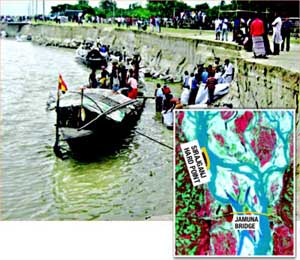Sirajganj Town Protection
Structural flaws put dyke at risk
The decade-old Sirajganj town protection embankment is at risk of caving in due to its faulty design, finds a panel of experts.
Several breaches and cracks have developed in the structure, raising the spectre of a collapse.
On July 25, a 100-metre stretch of the embankment caved in near the old jailhouse, adding to concern about erosion of the town by the mighty Jamuna.
In response, the Water Development Board (WDB) has assigned the experts’ panel to find out the reasons why the levee is falling apart.
Speaking to The Daily Star on condition of anonymity, a member of the panel said British firm William Balcrow and Partners drew up the design for the embankment on flawed measurement of the scour holes’ depth.
The firm measured the scour holes–hallows in the riverbed caused by undercurrents–to be 11 metres deep, while the WDB panel found them to be 17 metres deep near the structure along the Sirajganj district headquarters.
The embankment can hold the pressure of up to 11 metres deep scour holes. When the undercurrents scour the riverbed deeper than that, the pressure exceeds the capacity of the levee and the surface structure caves in.
“We are suggesting the authorities put more blocks and sandbags to ensure the structure remains stable even in case of holes with a depth of 22 metres,” the panel member said.
 During the 80s, the Jamuna started moving westwards devouring many important structures of Sirajganj town situated on its right bank including the jailhouse, a helipad, and the post office.
During the 80s, the Jamuna started moving westwards devouring many important structures of Sirajganj town situated on its right bank including the jailhouse, a helipad, and the post office.
Many establishments had to be relocated.
As erosion was threatening the existence of the town, the government decided to build the embankment with a loan from the World Bank.
The townspeople heaved a sigh of relief, as erosion on the right bank of the Jamuna stopped after the embankment was built.
However, that sense of relief did not last long as the threat of erosion returned thanks to the embankment’s faulty structural design.
The river has already come within 100 metres of the Shariakandi upazila headquarters.
“If we don’t intervene immediately, the structure is likely to collapse,” says a WDB official showing the trend of present current of the river that might hit the right dyke of the Jamuna Bridge next.
A WB document about the town protection embankment says the British company in association with Danish Hydraulic Institute Engineering & Planning made the Environment Impact Assessment and design of the embankment in 1992.
The company used secondary data mainly taken from the documents prepared earlier for Flood Action Plan.
Sources in the WDB say several breaches and damages had developed in the embankment in 1998, the year the structure was supposed to be completed.
The breaches delayed completion of the work till 2002 and increased construction cost by around 30 percent, bringing it to $186 million from $152 million when the exchange rate was Tk 40.25 to the dollar.
WDB Director General Habibur Rahman said that for now they are trying to save the structure by throwing in the river big concrete blocks and sandbags.
“We cannot do any major repair work during the monsoon; so we are taking just precautionary and temporary measures now,” he added.
“Later, we would repair it as per recommendations of the experts’ committee.”
The Jamuna, the main flow of the Brahmaputra, rolls down to Bangladesh crossing through China and India. After making a journey of 2,880kms, it empties into the Bay of Bengal through a joint channel with the Ganges, known as the Padma in Bangladesh.
-With The Daily Star input




















